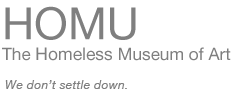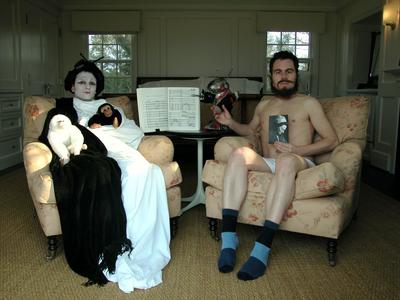Homeless is More
This early conversation between Noterdaeme and Isengart about the Homeless Museum reveals the unbridled vigor of a young art project in flux.
Recorded in Brooklyn, September 2003
Daniel Isengart: What exactly is the Homeless Museum?
Filip Noterdaeme: The Homeless Museum (HoMu) is not a museum in the traditional sense, but a conceptual work of art. It is a tool I created to raise questions about homelessness and the meaning of cultural institutions.
DI: What makes it a museum?
FN: The term "museum" is interesting because it evokes a set of clearly defined expectations that contrast radically with anything related to homelessness. I play with that contrast and use the term with a healthy dose of self-mockery. I have worked for many years within cultural institutions as an educator and lecturer, and I know their mode of operation quite intimately. Culture is a business like any other. Billions of dollars will be spent this year creating new cultural institutions and expanding existing ones. Art museums are increasingly relying on world-renowned architects to design buildings that become the most visible part of their institutional brand. But I believe that it is possible to be committed to advancing culture, to reach out to new audiences and provide means for learning and entertainment without building, without architecture, or, put differently, by remaining homeless.
DI: So what does the museum exhibit?
FN: My work encompasses many disciplines, such as film, writing, painting, installations and performance art. Right now, I am working on a series of abstract paintings that are based on homeless demographics. Aside from their titles, which are taken from the statistical data I used, you wouldn't know what these paintings are about: they look very clean and pure, almost decorative. But with HoMu being technically homeless, there is no such thing as a permanent exhibit. On occasion, I have had exhibitions in physical spaces such as artists' studios and galleries, as well as the streets. This being said, HoMu and its collections can always be viewed online at www.homelessmuseum.org.
DI: How did you get started?
FN: HoMu was inaugurated at an artist's studio in Chelsea in the summer of 2003. The show featured the first installment of The $0 Collection and was reviewed by Walter Robinson for artnet.com.
DI: Where does your personal interest in homelessness stem from?
FN: The homeless personify my deepest fears of failure. They remind me of my inability to conform in general and to gain financial stability in my life. I regard the homeless with a mix of fascination and horror, realizing that this could be me someday. Through HoMu, I have found a way to exorcize that fear, but the creation of the Museum is also an expression of my outrage towards our apathy in the face of homelessness.
DI: What do you think is the primary cause for homelessness?
FN: The obvious answers would be to blame either a poor social system or the homeless individuals themselves for failing to comply with society's expectations. The answer probably lies somewhere between these two extremes. In the end, each case must be viewed separately.
DI: What else are you currently working on?
FN: I'm developing a faux-documentary that spoofs Begin with Love, an educational video for first-time parents hosted by Oprah Winfrey, who, incidentally, never had children of her own. It's a collaboration with writer/performer Tim Cusick and will be called Open Your Door. The video will portray several couples or individuals who adopt a homeless person and talk about the first three months of their changed life. I will be in it, playing one of the adopters. We hope to start shooting this spring.
I also have a photo project called The Homeless Parade, a digitally engineered photomontage of a fictional parade of homeless people. It will show several bums, all played by myself in homeless drag, holding up signs like "Homeless Power" and "Homeless UNITE!" It's inspired by the Civil Rights Movement, Stonewall and gay activism. There are currently more than 40.000 homeless adults and children living in New York City. I argue that the homeless are a disadvantaged minority comparable to women, blacks and gays at some point in history or even today. Homelessness has become a new social identity that transcends gender, race and sexual orientation. The rendering of a parade is a projection of an imagined homeless liberation movement.
DI: Do you think it could eventually happen?
FN: It's bound to. The homeless should take their cue from civil rights movements and get organized. Homelessness is a crisis, and I think the homeless should follow the example of AIDS activists who ended up pouring the ashes of their friends on the lawn of the White House. Unless they go out there and fight for themselves, the homeless won't see any substantial changes. The solution has to come from within.
DI: Are there any planned exhibitions in the near future?
FN: Yes, I am going to introduce the HoMu Cart. The cart is essentially a tool to promote the Homeless Museum and stress the idea that we are a nomadic institution. I intend to position it in front of other museums, a little bit like a hotdog stand.
DI: How is it going to operate?
FN: It will be open to the public at odd hours: Whenever the museum in front of which the cart is positioned closes, we will open. And, during our business hours, we intend to project our HoMu logo onto the museum's façade. The underlying idea is to mark our presence on already existing institutions without interfering with their own operations. Aside from some kind of temporary exhibit, the cart will feature a membership desk as well as a shop.
DI: What are you going to sell in the shop?
FN: Nothing! You have to understand that HoMu really is a conceit of a museum. The same goes for the shop. But there will be "shopping items" on display, like HoMu mugs, HoMu T-shirts, HoMu golf balls, HoMu cigarettes and HoMu-branded, white M&Ms with home-less is more printed on them, courtesy of Mars, Inc. I actually had to outsmart their computerized censorship program to get the prints realized, because it wouldn't let me use words like homeless, museum or HoMu. Then, there are also the customized buttons I created for the eventuality of a homeless protest march. They are inspired by the famous Silence=Death logo and spell out Homeless=More under an orange triangle.
DI: Where would you like the Museum to be 5 years from now?
FN: I would like to see HoMu reach out beyond the art world and enter partnerships with the traveling industry, the fast food industry, home design corporations, or even pharmaceutical companies. For example, I imagine Mc Donald's creating Hungry Meals for homeless customers, K-Mart producing a line of fold-and-carry cardboard furniture, American Airlines to allow the homeless to panhandle on their domestic flights, and Pfizer Pharmaceuticals to distribute free Viagra pills to the homeless.
DI: Why distribute Viagra to the homeless?
FN: It would be a strong symbolic statement about powerlessness and the remedies we develop to palliate loss of virility. For me, the homeless, regardless of gender, are emasculated beings. To put it bluntly, homelessness is a form of social erectile dysfunction that is still waiting for its remedy or quick fix. Besides, I'm sure they could use it.
DI: What do you reply to people who reproach you for being cynical?
FN: My approach to homelessness is not cynical, but deliberately subversive and surreal. I am creating situations that are provocative and nonsensical because I believe that the absurdity of homelessness and its parallel in our "privileged" society, emotional and spiritual poverty, cannot be expressed rationally. Also, people are much more likely to pay any attention to a weighty topic such as homelessness when it's devoid of blame and whininess or cheap sentimentality.
DI: How does one become a member of the Museum?
FN: Anyone who donates spare change to a homeless person can technically regard himself a member. If you register with HoMu online, you get the benefit of being regularly informed of the Museum's activities.
DI: A final question: What's your view on panhandling?
FN: Whenever I spot a panhandler on the subway, I follow him or her from car to car to check out their act. What used to be a burden to witness and listen to has become a form of entertainment. Subway panhandlers are truly fascinating: they keep repeating their act over and over again, maybe 50 times a day! My favorite panhandler on the subway is the one who continuously celebrates his sixtieth birthday; every time I spot him, it's his sixtieth birthday - you don't know if you want to laugh or cry.
© 2003 Filip Noterdaeme (HoMu)

